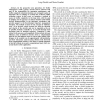Free Online Productivity Tools
i2Speak
i2Symbol
i2OCR
iTex2Img
iWeb2Print
iWeb2Shot
i2Type
iPdf2Split
iPdf2Merge
i2Bopomofo
i2Arabic
i2Style
i2Image
i2PDF
iLatex2Rtf
Sci2ools
CDC
2010
IEEE
2010
IEEE
A geometric approach to air traffic complexity evaluation for strategic trajectory management
In the perspective next generation Air Traffic Management (ATM) systems, aircraft will be endowed with part of the responsibility for separation maintenance, and traffic complexity reduction functions are envisaged to play an important role in avoiding to overload the on-board conflict resolution system. In this work, we introduce a method to assess air traffic complexity in the long term, with the goal of pointing out the presence of critical situations with limited aircraft manoeuvrability in the time/space coordinates, and provide support to the flow/strategic trajectory management functions. The method is based on the concept of "influence zone" of an aircraft, which accounts for both the direction and velocity of the aircraft, and can be regarded as the set of possible locations reachable by an aircraft through local deviations from its intended trajectory. Complexity is then related to the presence and magnitude of intersections between influence zones of different airc...
| Added | 28 May 2011 |
| Updated | 28 May 2011 |
| Type | Journal |
| Year | 2010 |
| Where | CDC |
| Authors | Luigi Piroddi, Maria Prandini |
Comments (0)

